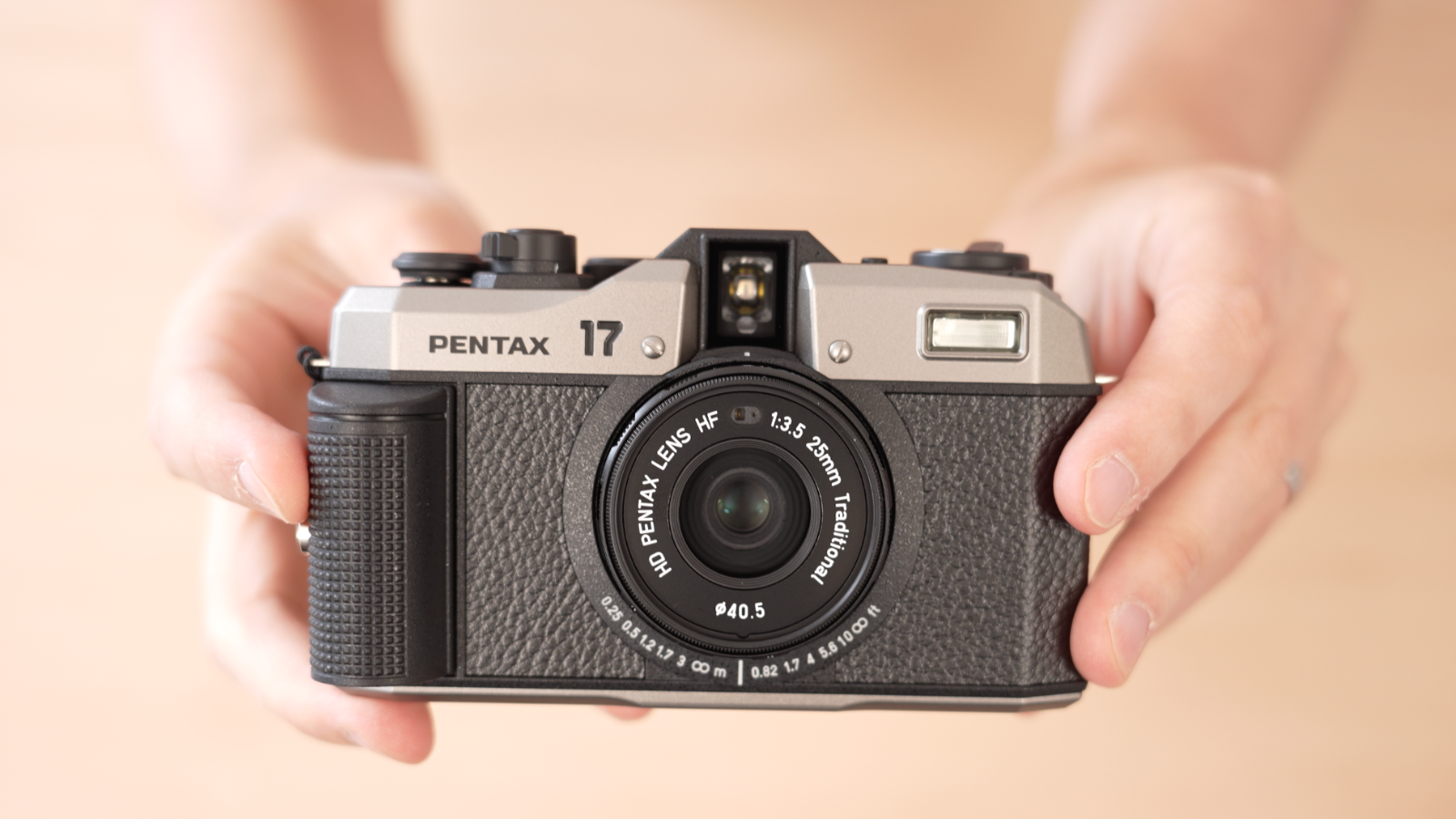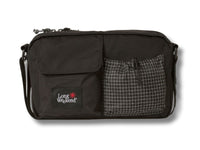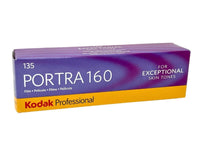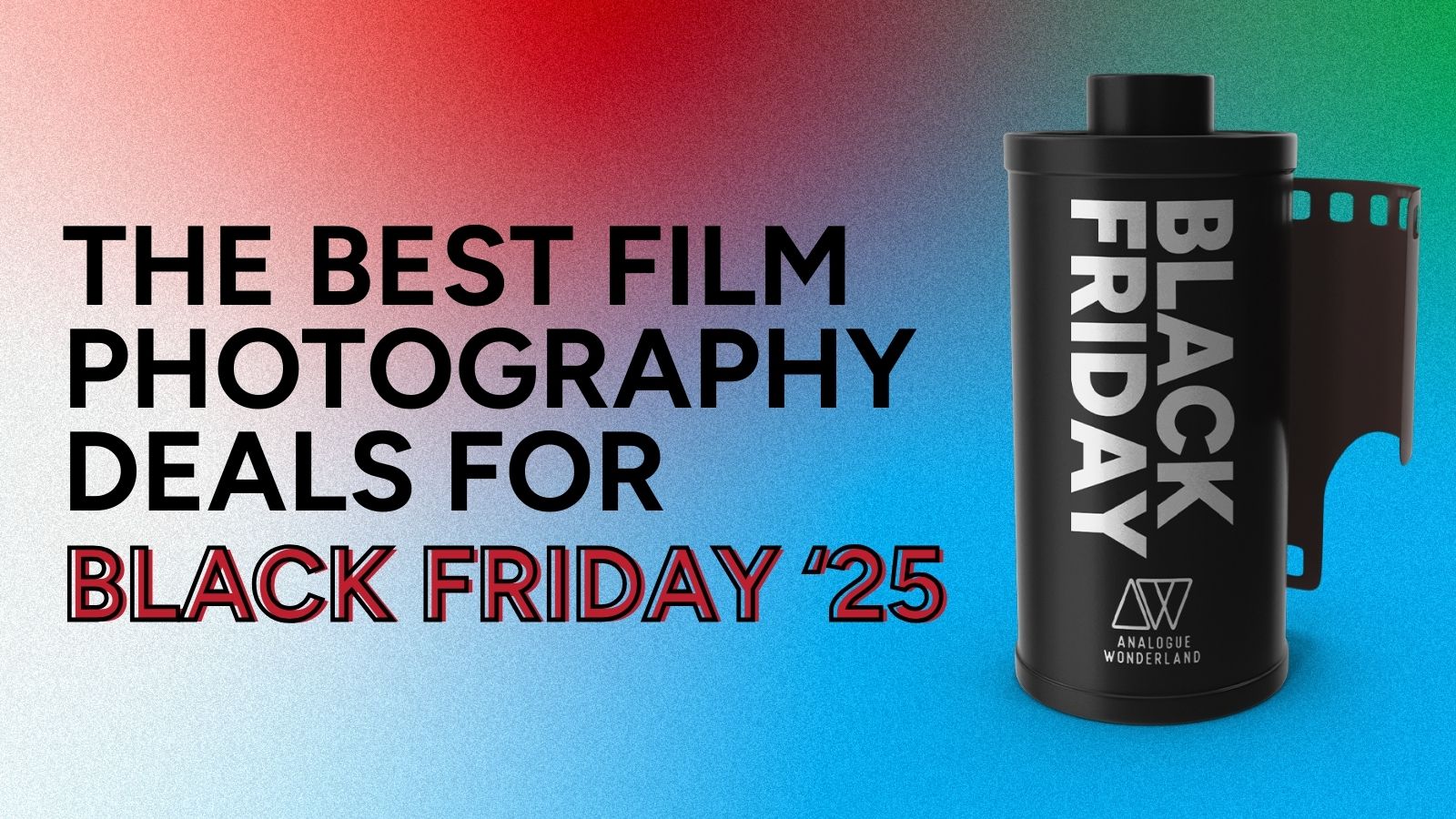Black Friday 2025 has landed at Analogue Wonderland, bringing some of our biggest film photography deals of the year - from discounted film and cameras to money-saving WonderLab processing offers, exclusive bundles, and festive specials available for a limited time only. Grab a great deal while stocks last!
Recent posts
Shop the article

Pentax 17 Camera Review: A Modern Wonder
By Paul McKay
We’ve been lucky enough to have been involved in the Pentax Film Project for several months now - sworn to secrecy - as the Pentax / Ricoh company inched closer to bringing a brand new film camera to market. And that moment of launch has now arrived, with the Pentax 17 Half-Frame Camera a reality! We have stock in the warehouse (place your order here to be one of the first in the UK to enjoy the moment 🎉) and I can finally share my experience of shooting the Pentax 17 camera.
How does the camera feel in my hand, what do its different settings mean, how does it perform in different lighting situations, and what are the results with different films? I’ve put thorough multiple rolls and taken literally hundreds of sample photos with the Pentax 17 so we have lots of images to learn from. Let’s get started!
Why Pentax 17?
The name is striking and simple, and gives an immediate clue to its format. The Pentax 17 is a half-frame 35mm film camera. This means it shoots two images on a single 35mm frame, which measures 36 x 24mm. Halve the width, remove a millimetre to give each image some space, and you get [36/2 - 1 =] 17mm.

Half-frame negative at the top; full-frame 35mm at the bottom
Each photo taken on the Pentax 17 film camera will measure ~17 x 24 mm on the negative strip. This is obviously half the size of a 35mm photo, but is also in portrait orientation instead of the traditional landscape. Shooting twice as many photos also has the happy impact of halving the price per photo, so half-frame is a highly cost-effective format for film shooters. I’m not going to spend too much time on half-frame versus full-frame (we have more half-frame details and tips here if you’re interested) as frankly the comparison isn’t as useful as just focusing on understanding what this camera can do!
First impressions of the Pentax 17 film camera
My first feeling when I unboxed the camera was one of awe. Having spent the past two decades buying 35mm film cameras secondhand, it is an incredible experience to be greeted with a brand new box and an instruction manual in multiple languages. The camera smells new, it is shiny and untouched, and you’re the first person to put a battery into the compartment. This is a wonderful experience that has been denied to 35mm film photographers for nearly twenty years!

Of course I know that Lomography have been making new cameras consistently through the past three decades without pause, and I own many of them personally. Their packaging is wonderfully presented and super-creative - unique to the Lomography brand - but I never felt like it was opening a high-end DSLR! That's not a bad thing, it’s just different. Check out our unboxing of their Lomomatic and you’ll see what I mean…
The Pentax 17 camera comes with a wrist-strap, a lens cap, and a CR2 battery to power its electronics and flash. The wrist-strap has a hidden talent I’ll reveal later! The battery should be able to power 10+ rolls of 35mm film before needing replacing which is 700+ half-frame photos.

Paul out and about with the Pentax 17 📸
The battery compartment doubles as a useful grip for your right hand, and is simple to open with a coin or screwdriver.
The camera feels light but solid. It weighs about 300g without film. Compact enough to slip into a small bag or coat pocket, with a smooth design that means I won’t worry about it being damaged by something being knocked. There is no official travel case (yet…) so I’ve been using the Long Weekend Sante Fe camera bag and found it to be perfect with plenty of space for some extra films and a notebook.

The top-down view of the Pentax 17. From left to right you can see the ISO dial and rewind knob, exposure compensation, viewfinder, shooting mode dial, on/off switch around the shutter button, and the winding lever
There are setting dials along the top of the camera, a manual film advance lever, a power switch to turn it on and off, and a window at the back to hold the end of the film box so you remember what you’ve loaded! The camera has an aux input for using an electronic cable release, and on the bottom there’s the tripod thread and rewind button.
The Pentax 17 has an inbuilt flash which you can leave in automatic mode (the camera decides when to use it) or turn on/off yourself by choosing different shooting modes. The flash is pretty powerful for such a small unit - one of the several moments that I really noticed the benefit of modern tech in an analogue camera!
Pentax 17 shooting modes
The Pentax 17 film camera is effectively an auto exposure camera in aperture priority mode (with a couple of exceptions). This means that you tell it how much light you want to capture in each photo - via the ISO setting and the exposure compensation - and whether you want a large aperture, small aperture, or you don’t mind - and then press the shutter to expose the film. The camera is taking on the responsibility of managing the Exposure Triangle.

This gives you six different settings. The instruction manual will give you some basic guidance and I've tried to translate them to aperture/shutter numbers as follows:
| Setting | Aperture | Shutter | Flash? |
|---|---|---|---|
| AUTO | Probably f/16. Also note that focus is fixed at infinity in this mode. | Whatever is needed: under 1/30s | Only if needed to keep shutter speed under 1/30 |
| White P (Program) | Varies, aims for f/8ish | Whatever is needed: under 1/30s | No |
| White moon | f/16 | Whatever is needed - probably quite long, up to 4 seconds | No |
| White BOKEH | f/3.5 | Whatever is needed: probably quite short | No |
| White B (Bulb) | f/16 | As long as you press the shutter! | No |
| Yellow P (Program) | Varies, aims for f/8ish | Whatever is needed: under 1/30s | Yes |
| Yellow moon | f/16 | Whatever is needed - probably quite long, up to 4 seconds | Yes |
I appreciate you may still find this a bit confusing, especially if you’ve come from fully manual film cameras - or cameras with no settings at all! So let's make it easier.
In my experience this is how I’ve used each setting:
- Auto. When I don’t want to think about any settings (even flash). Honestly I can’t imagine ever using this, as I’ll always want to decide if flash is on or off. It also doesn’t work for anything closer than 1.2m away. So it’s a good party mode but not much more.
- Program (with and without flash). This is my ‘everyday’ setting - for photos near and far, and I get to choose whether to use a flash. Program with flash is also useful when a subject is in shadow or backlit to add fill flash.

Program mode: without flash (left) and with flash (right)
- BOKEH (without flash). This is my ‘macro’ mode - it forces a very narrow window of focus, and as long as you’re accurately measuring the distance from the lens then it can create some amazing subject separation.

Macro mode! BOKEH + close focusing = 😍
- Moon (without flash). This is my long-exposure mode. Pop the camera on a tripod or stable surface to absorb low levels of light over a long period of time, or capture some brilliant motion blur!

On the left - it was dark at a music festival so I braced the camera on a post to catch the tree's under-lighting. And then on the right - experimenting with HP5 under a bridge - on moon mode the focal plane is deep and you get lovely motion blur from the slow shutter
- Moon (with flash). Atmospheric party photos - in a dark environment this will do a flash to expose a subject close to the lens but will then stay open to expose the background with natural light. Can be tricky to master, but really useful.

Definitely not a perfect execution - I was hand-holding rather than on a stable surface. But you can see the main subject of frozen by the flash whilst the background is still clearly exposed (with some light blur!) by the shutter remaining open.
- B (bulb). Super-long exposures where I know the camera’s inbuilt meter won’t be able to accurately calculate what’s needed. So astrophotography, or light painting, a nicely blurred carousel spinning round at a Christmas market, or your favourite band in motion.

Shot at a music festival with the camera held stable - the lead singer is turned into a ghost by the multi-second exposure, while the background is (relatively) still and in focus
A quick point on the flash. Remember that this is a film camera and not digital - so you can’t change ISO to improve effective range! If you have a 400 ISO film loaded then the flash is effective to about 2m away; if you have a 100 ISO film loaded then it will only be effective to about 1m. I’d also be very wary about using the flash any closer than 0.5m away - you’ll start getting some strange side-shadows as the flash is slightly offset from the lens. It takes about 9 seconds to fully charge each time - not immediate but also not painful.

Having said that, this one turned out remarkably well - ISO 200 at 25cm in macro mode!
The ISO wheel is very simple to navigate. I love that it can cope with everything from ISO 50 to ISO 3200 - with stops for 125 and 160 among others. So now you have no excuse to not shoot Kodak Portra 160 film!
And the exposure compensation dial gives you a fast way to nudge the auto exposure calculation up or down 2 stops for specific shots, as you get a feel for the true lighting in a scene.
Setting the focus on the Pentax 17
The Pentax 17 is a zone-focus camera. This means that you set the focus from estimating the distance from your subject, rather than being able to focus ‘live’ through the viewfinder like an SLR or TLR. The camera doesn’t autofocus - although interestingly it does electronically focus - which I’ll talk about in more detail when I consider what’s next for Pentax. For now that means that there is a slight pause when you half-press the lens that allows the camera to calculate aperture and to move the lens to your pre-selected focal distance. This disallows the possibility of an instantaneous photo - which might be an adjustment if you normally shoot a manual SLR or rangefinder - but I never found it an issue in real world use.

The focus is set via a dial around the lens. It has symbols at the top, with corresponding metres and feet at the bottom of the lens so you can choose your measuring system! The symbol at the top is always visible through the viewfinder which is fantastic for quickly checking that you’re not pointing macro mode at a mountain.
| Symbol | Focus Distance (m) | Focus Distance (ft) |
|---|---|---|
| Flower | 0.25 | 0.82 |
| Cutlery | 0.5 | 1.7 |
| Person | 1.2 | 4 |
| Two people | 1.7 | 5.6 |
| Three people | 3 | 10 |
| Mountain | ∞ (Infinity) | ∞ (Infinity) |
In most situations with good light and a fast film then you won’t need to worry too much about the exact focus in the 1.2-3m range. The camera will have set a large enough aperture that anyone in that area will be in focus.
You will need to be more careful when you’re using BOKEH mode, have an ISO 50 or 100 film, or there’s not much light and you’re not using flash. All of these situations will make it more likely that the camera selects a large aperture of F3.5 or similar and the focal plane will become very narrow.
On the plus side these are also the situations where an accurate focus will result in gorgeous subject separation and background blur!

I love the way this came out! The point of the straw in focus and then a fast fall-away, but you can still make out the full scene. Delicious in all senses of the word
I have been really impressed by the close-up focus settings. This is a really good camera for macro photography! Possibly not in the traditional sense of being able to isolate a single insect on a leaf, but the ability to capture something 25cm away in perfect detail is pretty mind-blowing.
Which brings me to the secret power of the wrist strap. When you hold the wrist strap at full tension in front of the lens then it measures exactly 25 cm from the tip to the film plane. At first I thought ‘oh that’s cool but maybe not that useful in real life’... Dear reader, I was WRONG! It is an invaluable tool for being able to get close to a flower, an animal, a baby, and immediately spot the focal point.

The viewfinder of the Pentax 17
When you raise the camera to your eye you can see a few things at once.
Firstly - your subject. Hurrah! Remember that it will always be in focus through the viewfinder and always visible even with the lens cap on, so don’t forget to set the focus separately. Which brings us to point two: the focus symbol will be visible in the bottom centre of the viewfinder. Invaluable to avoid accidents, and you can then rotate the focus ring to the right setting without having to pull the camera away from your eye. Compose and focus all at the same time!
The framing guidelines. There are two frames. The larger one is for everything 1m+ and the smaller one for things closer than 1m. Obviously it’s not quite so binary as that, but using the combination will give you a good idea of where the edge of your photo will be. When in doubt step back and include more - you can always crop when you edit/print the final image.

And finally there are two lights on the right side that may or may not light up - but if they do then they’ll be telling you important information for your photography. The orange light is the flash light, the blue light is the warning light. You can see these lights at a distance - when the camera is on the table in front of you - but also when you have your eye pressed up to the viewfinder. Invaluable!
| Situation | Lights | Problem |
|---|---|---|
| You turn the camera on | Blue and orange lights both blink quickly and alternately | The battery is dead (or nearly) |
| You turn the camera on | Blue light blinks quickly | You’ve left the lens cap on |
| You’ve half-pressed the shutter in preparation for a photo | Blue and orange lights both blink quickly and alternately | The battery is dead OR you’ve not wound on the film |
| You’ve half-pressed the shutter in preparation for a photo and you’re NOT in bulb mode | Blue light blinks quickly | There’s not enough light for a photo OR the flash hasn’t charged yet |
| You’ve half-pressed the shutter in preparation for a photo and you’ve set the focus distance under 1m | Blue light blinks slowly and calmly | The camera just wants to remind you you’re in ‘macro’ mode in case it’s a mistake! |
| You’ve chosen a mode with flash | Orange light blinks slowly | The flash is still charging |
| You’ve chosen a mode with flash | Orange light is constantly on | The flash is now charged |

Both warning lights blinking quickly = your battery is dead or you haven't wound on the film 😂
The Pentax 17 lens
The lens of the Pentax 17 is exceptional. That’s it. All I can say. The quality is absolutely phenomenal, and every time I get sample photos back from our in-house film processing lab I'm more and more impressed.
Important caveat: I’m used to 40-year-old lenses and new-but-plastic lenses. I have no idea if someone who reviews digital cameras for a living would agree with me, but I suspect that most of you reading this are going to share my shooting history!
And from my perspective there seems to be a huge benefit to Pentax’s digital expertise being brought to bear on the Pentax 17 kit. There have been significant technical breakthroughs in alignment, manufacturing, and coating over the past two decades - and that’s all been baked into the 25mm ‘pancake’ lens that comes fixed to the Pentax 17 body.

There is SO much detail in these photos! Download a full res example here if you want to check it out for yourself
When we met with the Japanese product team - including the legendary TKO 🤩 - they said that a good way to think about it is to imagine the base design of the Pentax Espio lens - with triple elements - PLUS all the latest coatings and tech from their digital division. Specifically the lens has:
- HD coating, which maintains high performance of the lens, by using this PENTAX multi-coating. This also enables high contrast and high definition right to the edges.
- SP coating (Super Protect) which helps to repel water and oil from the lens.
To quote their press release "Using the lens used in the RICOH Au-to Half (a best-selling half-size model first marketed in 1962) as a reference, the angle of view and focal length were selected to make casual, everyday picture-taking simple and flawless."
The lens has a 40.5mm filter thread so that you can easily add filters: filters, UV, colour, ND, or anything else you want to tweak the image captured on film.
In my experience so far the lens is crisp right across the field of view; able to resolve an extraordinary amount of detail; and I haven’t yet experienced any leaks or glare - even under bright light.
But enough words - the true measure of a lens is the imagery. I’m not going to pretend any of my sample photos are great art, but they do show what’s possible!






Which films to use with the Pentax 17
I've been shooting a lot of 24 exposure 35mm film on the Pentax so far. That's partly a practical choice - it allows me to get results faster within this initial testing phase - but also a personal one. Although it is the most cost-effective use I find 72 exposures (2 x 36) a daunting photographic obstacle! Having 48 (2 x 24) is still a luxury for a 35mm camera, but a more manageable amount to shoot on a day out.
The beauty of having an ISO wheel that covers 50-3200 (and with exposure compensation that can be stretched to 12-12800) means that nearly every 35mm film we sell can be loaded into the Pentax 17 and the autoexposure computer will be able to cope.

Films shot on film - I've tried both Ektar and HP5 so far with the Pentax 17, along with a ton more colour films
So far I've been shooting with some of our most popular films: Ilford HP5 for black and white, Kodak film (Ultramax, Gold, Ektar and ColorPlus) for colour.
I've been incredible impressed with the results from every roll of film. I've been matching the ISO and the colour to the lighting situation (Colorplus at a team curry, HP5 on a grey day, Ektar for flowers in the sun) and the images have been incredible. I've even
My plans for the coming weeks is to shoot some of the really detailed professional films. Something like T-Max 100 to see just how sharp we can get large prints, and Ektachrome to understand how beautiful slide film looks with the Pentax 17.
For now I'd recommend beginning with a film that you know, or a film with a midrange ISO (200-400), so that you can get used to the Pentax 17's settings and flash before stretching it's creative potential.
My favourite things
Having carried the camera around for a few weeks, I can confidently say that it’s become an extension of my shooting arm. This only happens with a fraction of the cameras I use, and honestly I wasn’t sure at first sight if the Pentax 17 would become one. I was a little worried about the ergonomics of the battery grip, the initially-confusing settings (why say BOKEH but only write B for BULB?!), and the different framing lines in the viewfinder.

My rabbit wonders why B doesn't stand for 'Bunny'
Maybe if I’d stopped after 1 or 2 rolls of film then that would have been true, and I’d have set the camera aside thinking ‘not for me’. But I’m thrilled that more usage has come with a corresponding increase in my affections. Ultimately what’s made the difference is three things:
- The quality of the camera. The build is so solid, the electronics so reliable, and it feels SO good to use. Even walking around town with it in my hand, it’s a perfect compact camera and is only ever one switch away from capturing a moment.
- The warning lights! Honestly, they’re so useful. And as soon as I learned the 5 or 6 codes then they fade into the background, as I just absorbed what they were telling me and adapted/ignored accordingly. They dramatically reduce the likelihood of making all the common film mistakes, which in turn reduces any frustrations with the camera. Really neat.
- The results. I’m only a few months into my half-frame journey and the Pentax 17 camera is the ultimate companion for creating portrait artwork. I honestly can’t imagine it leaving my camera bag in the foreseeable future, and I already LOVE some of my sample photos!
My wishlist - the Pentax 17 ii
That being said, there are a couple of things that I wish had been added or amended to the Pentax 17. Nothing that makes it a problem, but I’m already in dreamland so why not keep aiming high!
First up is a proper case for travel. Personally I love the old leather-and-metal cases that came with the Olympus OM SLRs back in the 70s, but even a modern moulded case would ease my fears when carrying it in a backpack or rucksack.
I’d also have loved a hot shoe for mounting an external flash. The inbuilt flash is brilliant for day-to-day snaps but for any serious work I’d want to be able to elevate or move the point of light.

For an inbuilt flash it is really impressive, but I'd still love the option of an off-camera unit
Maybe this is the Lomographer inside me, but I adore taking multiple exposures. The Pentax 17 flashes warning lights at me when I try, and forces me to wind on the film. Is there such a thing as a firmware update that could allow me to override this (understandable) safety measure and go wild with doubles?
Finally, when I reviewed the very first sample photos I realised I was having trouble with accurate framing. On further investigation I noticed that the framing lines are sometimes hard to see - for example against the sky - and they appear/disappear with very small movements of my head. This might well be user error - I can’t remember the last time I used framing lines - but it means I now have to frame wider than I expect to allow for a small crop.
Top tips for using the Pentax 17 film camera
From the several hundred sample photos I’ve already shot on the Pentax 17 film camera I can pull out some common themes:
- Measure twice, photograph once. At least when it comes to macro mode, taking the time to use the wrist-strap’s secret power - or getting out a ruler - will pay dividends in the final image
- Use the right film for the right light. Otherwise known as: don’t assume a modern film camera can compensate for ignoring the basics of analogue art! If it’s grey and cloudy then don’t expect bright colours - grab a roll of black and white and aim for textures and shapes instead. If you know you’re going to be using a flash then don’t load Portra 800 and be surprised when all your friends are overexposed. And on the positive side: this is a camera that will bring the best out of slide film on a sunny day, and allow you to print Adox HR-50 images to the size of your house!
- Enjoy it! The Pentax 17 is light, it’s unbelievably user-friendly, and your digital friends will love it. So share it round, shoot lots, get to know its unique view of life, and relax knowing that you’re holding a modern film camera in 2024. What a time to be alive.

Look how happy I am! 😅
What’s next for Pentax
Pentax have not publicly released any information on what else they might be researching or building, I suspect that they’re waiting to see sales of the Pentax 17 before committing anything else to the film community.
However I am very confident that they have some top secret plans for the next iteration of the Pentax Film Project. And from a personal view I would love to see a couple of things in the next camera.
The first is autofocus, but as an optional setting. This would make the ‘auto’ setting on the Pentax 17 more of a true party mode, and would reduce some of the distance calculations while out-and-about. I wouldn’t want it to become default as I have too much experience with pure autofocus film cameras that persistently get it wrong and you can’t override. It’s a similar story with autofocus cameras that flat-out refuse to take any photos in dark scenes where they can’t ‘see’ the subject properly. So for my money it must be something that can be turned on / off - and I’m confident that Pentax have the ability to make it pretty special. The fact that the focusing on the Pentax 17 is electronic i.e. the lens only moves when you half-press the shutter gives me faith that autofocus was already considered in the R&D stage.
And finally… oh go on then I’ll say it. Yes please to full-frame 35mm! I don’t have the instinctive recoil against half-frame that I know some analogue shooters experience, but full-frame is ultimately where I’ve spent most of my time and I would adore Pentax to bring all the brilliance of the Pentax 17 into a full body.
However I refuse that to be the last point of my Pentax 17 review! This is a fantastic camera that is capable of taking breaktaking photos, has the potential to introduce a whole new generation of photographers to the joy of film, and is an absolute delight to use in daily life. What are your thoughts - are you tempted to pick up a Pentax 17 camera and start experimenting?
Ready to dive in?
Keep Reading
View all
Christmas 2025: Shipping & Opening Hours
Christmas 2025 is fast approaching! To make sure your analogue goodies arrive in time, take note of our last shipping dates, plus opening and operating hours over the festive season. We've got everything you need to gift the magic of film photography this Christmas!

Film Photography Christmas Gift Guide 2025: Analogue Wonderland
Capture the magic of Christmas with film - no filters needed. Our 2025 Film Photography Christmas Gift Guide 2025 is packed with thoughtful presents for every type of shooter, from curious beginners to seasoned photographers. Discover film stocks, cameras, and creative accessories that will make this festive season truly memorable.
Subscribe to our newsletter 💌
Sign up for our newsletter to stay up to date on film photography news, sales and events:
Free Tracked Shipping
On all UK orders over £50
Passion For Film
An unbeatable range and an on-site lab
Our Customers Trust Us
Thousands of independent 5* reviews
All Deliveries are Carbon Neutral
Independently audited and verified by Planet
- Opens in a new window.








33 Comments -
Kilroy • -
stuart • -
Clipping path service • -
Industreel • -
Industreel •
1 2 3 … 7 →
Paul,
Please tell me were you took the canal photo. It looks like Eger, Hungary. Thanks.
Cheers,
K
This review is spot on. I’ve been living with the 17 for over 6 months and shooting with it professionally to boot.
I did have an issue with the lens focus setting locking up but Pentax fixed it for free and fast under warranty.
It’s definitely a quirky camera but it’s fun to shoot and you get lovely lo-fi vibe filled images. Don’t expect it to be a Pentax 6×7 of course LOL. You can open the back mid-roll and get lovely light leaks without negatively affecting film advancement too.
The two things that really bother me are the lag when making an exposure and the flash recycle time. I find that I do indeed miss moments due to both of these factors.
If they release a “pro” version with autofocus, instant shutter actuation and either a faster recycle time on the flash or a hot shoe option I would honestly pay double for that camera.
Honestly I’m ambivalent about half frame vs full 35mm but I guess that would be nice as long as the camera doesn’t get bigger.
This was such a fun and detailed review! Loved learning about the Pentax 17 and how it brings modern touches to film photography. The half-frame format sounds super cost-effective too. Your excitement is contagious—makes me want to try one myself!clipping path service
Great article here and very relevant. We film manufacturing videos throughout the UK and it is a hard business – long lead times etc. It still involves some sort of story telling when introducing the brand, the people etc. https://manufacturingvideos.co.uk
Good article. I’ve been working in filming manufacturing automation – mostly filming the manufacturing process as a comms / sales tool to investors. Keep up the good work, Luke https://industreel.co.uk